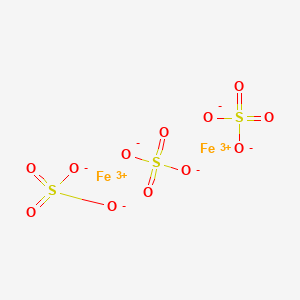

1. Ferric Sulfate Heptahydrate
2. Ferric Sulfate Hexahydrate
3. Ferric Sulfate Hydrate
4. Ferric Sulfate Monohydrate
5. Ferric Sulfate Nonahydrate
6. Ferric Sulfate Tetrahydrate
7. Ferric Sulfate Trihydrate
8. Ferric Sulfate, Basic
9. Polyferric Sulfate
1. 10028-22-5
2. Iron(iii) Sulfate
3. Iron Persulfate
4. Ferric Persulfate
5. Iron Sesquisulfate
6. Iron Tersulfate
7. Iron(3+) Sulfate
8. Diiron Tris(sulphate)
9. Diiron Trisulfate
10. Ferric Tersulfate
11. Ferric Sesquisulfate
12. Iron(3+);trisulfate
13. Iron Sulfate (fe2(so4)3)
14. 4ykq1x5e5y
15. Coquimbite Mineral
16. Iron Sulfate (2:3)
17. Ccris 7885
18. Iron(3+) Sulfate, (2:3)
19. Hsdb 6311
20. Einecs 233-072-9
21. Mfcd00011007
22. Unii-4ykq1x5e5y
23. Sulfuric Acid, Iron(3+) Salt
24. Iron-s-hydrate
25. Iron(iii)sulphate
26. Ferric Sulfate (usp)
27. Sulfuric Acid,iron Salt
28. Iron(iii) Sulfate(vi)
29. Diiron Trissulfate Hydrate
30. Polyferric Sulfate(spfs)
31. Diiron Trissulphate Hydrate
32. Ec 233-072-9
33. Iron(iii) Sulphate Hydrate
34. Ferric Sulfate [mi]
35. Ferric Sulfate [inci]
36. Ferric Sulfate Anhydrous
37. Dtxsid5029712
38. Ferric Sulfate [who-dd]
39. Chebi:53438
40. Iron(iii) Sulfate (fe2(so4)3)
41. Ferric Sulfate Hydrate 500gm
42. Akos015903761
43. Ft-0627289
44. D08922
45. Q409021
| Molecular Weight | 399.9 g/mol |
|---|---|
| Molecular Formula | Fe2O12S3 |
| Hydrogen Bond Donor Count | 0 |
| Hydrogen Bond Acceptor Count | 12 |
| Rotatable Bond Count | 0 |
| Exact Mass | 399.725060 g/mol |
| Monoisotopic Mass | 399.725060 g/mol |
| Topological Polar Surface Area | 266 Ų |
| Heavy Atom Count | 17 |
| Formal Charge | 0 |
| Complexity | 62.2 |
| Isotope Atom Count | 0 |
| Defined Atom Stereocenter Count | 0 |
| Undefined Atom Stereocenter Count | 0 |
| Defined Bond Stereocenter Count | 0 |
| Undefined Bond Stereocenter Count | 0 |
| Covalently Bonded Unit Count | 5 |
Seventy primary molar teeth, carious exposed, symptom free, without any sign of root resorption in children aged from 3 to 6 years (main age 4.3 yr) were treated with conventional pulpotomy procedures. Ferric sulfate 15.5% solution (applied for 15 second for 35 teeth) and formocresol solution (five minute procedure of Buckley's formula for next 35 teeth) have been used as pulpotomy agents. In both groups, pulp stumps were covered with zinc-oxide eugenol paste. Permanent restorations were stainless steel crowns. Clinical check up was every three-months and radiographic follow-up time was six and twenty months after treatment. Our results within this period revealed 100% clinical success rate in both groups. Radiographic success rate was in both groups 97.2%, while in 2.8% cases has shown internal root resorption.
PMID:11314410 Ibricevic H, al-Jame Q; J Clin Pediatr Dent 24 (4): 269-72 (2000)
The hemostatic efficacy, as well as the cardiovascular effects, of two hemostatic agents currently used during endodontic surgery was examined. The hemostatic agents used were epinephrine pellets (Racellet pellets) or 20% ferric sulfate (Viscostat). Patients were assigned to one of two experimental groups. Blood pressure and pulse rate were recorded pre- and postoperatively and at three additional times during the surgery (root-end resection, root-end preparation, and filling). The adequacy of hemostasis was rated by the surgical operator. Results indicated that there is no significant change in cardiovascular effects when using either of these hemostatic agents. Except in one case where ferric sulfate was the agent, both agents produced surgical hemostasis that allowed for a dry field for root-end filling.
PMID:12043873 Vickers FJ et al; J Endod 28 (4): 322-3 (2002)
The bioavailability of ferrous and ferric iron following cecal infusion was compared by assessing the hemoglobin regeneration method in ileally fistulated anemic rats. Rats were fed an iron-deficient diet (8 mg Fe/kg diet) for 14 days after recovery from surgery. The anemic rats were then divided into three groups of 11 rats. Group 1 (control) was fed an iron-adequate diet (45 mg Fe/kg diet) and infused with NaCl solution (150 mM). Group 2 and 3 were fed an iron-deficient diet and infused with ferrous sulfate [Fe(II)] suspension or ferric sulfate [Fe(III)] solution (800 ppm as Fe, pH 6.8) to provide the same amount of iron as that consumed one day before by the control group. NaCl, Fe(II) and Fe(III) were infused through the fistula as two times (1000 hr and 1800 hr) for 14 days. The volume of NaCl infused was about equal to the volume of Fe(II) suspension and Fe(III) solution infused. Hemoglobin regeneration efficiency, hematocrit, plasma iron concentration, transferrin saturation, total iron-binding capacity, iron contents in organs (liver, spleen and kidney), body weight gain and food intake were almost the same among groups.
Kiyoshi E, Jun O; Nutr Res 15 (6): 889-897 (1995)